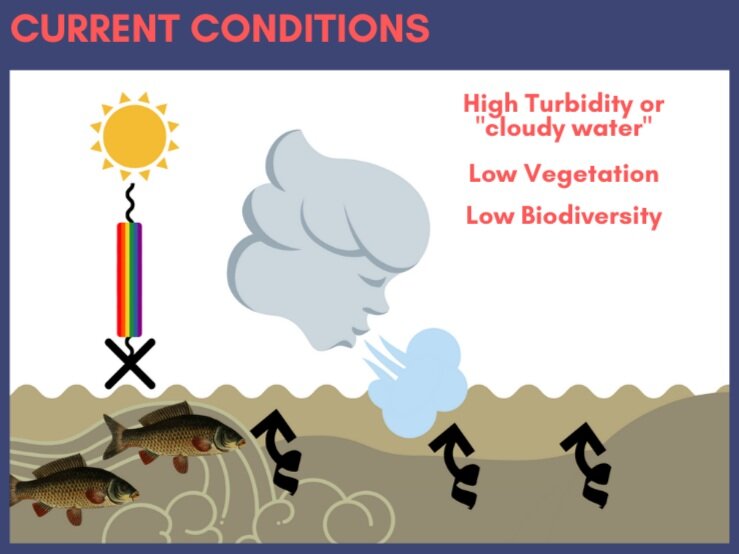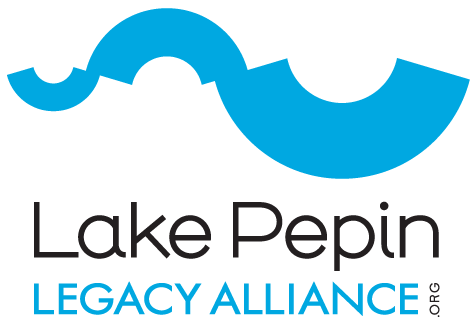Restoration Projects on Lake Pepin
Bay City Restoration Project
LPLA spearheaded a habitat restoration project to improve water quality, fish & wildlife habitat, and recreational access at the head of Lake Pepin in the backwaters near Bay City, WI. The project broke ground in the spring of 2023 and relies on restoration techniques that were developed by the Upper Mississippi River Restoration Program and have been successfully implemented on large river systems worldwide.
The main features include: 1. dredging deep pools and access channels, 2.constructing peninsula extensions, and 3.planting native vegetation. Each feature on its own creates important habitat, but together, they work to reduce the wind and wave action that stirs up sediment from the lake bottom. The goal is that water quality improvements will spark additional ecological benefits.
Upper Lake Pepin has a water quality impairment for turbidity, which refers to how much sediment is suspended in the water. High turbidity water, which looks like chocolate milk, reduces light penetration and thereby impedes the growth of healthy vegetation. Without healthy vegetation, ecological systems are vulnerable to cascading impacts to fish and wildlife populations.
Project Overview
-
LPLA spearheaded restoration through the ACOE Beneficial Use of Dredge Material Program (Section 204) to ensure it was financially feasible. The project relies on the same techniques used in the Upper Mississippi River Restoration Program, but at a lower overall cost because the dredge material needed for construction is excluded from the local cost-share.
After planning began, the WI DNR and LPLA co-sponsored an application to be considered for a federal pilot program (ACOE Section 1122) that boosts funding to projects that use dredge material for social and ecological benefits. In January 2019, Lake Pepin was one of only ten projects selected nationwide and only project selected on the Mississippi River.
-
• Increase emergent & floating leafed aquatic vegetation
• Increase submerged aquatic vegetation.
• Redirect sediment accumulation to improve habitat and species diversity.
• Improve or maintain habitat for riverine aquatic species.
• Improve or maintain habitat for migratory birds.
• Improve or maintain habitat for backwater fish.
-
Large access channels will be dredged to access the construction area and the Bay City Harbor. They will improve recreational access to the area after construction.
-
Deep pools will be dredged to create habitat for overwintering fish. Bass, crappies, bluegills, and other recreational fish require at least 3 feet of depth, low water flows, and heathy oxygen levels during the winter. The deeper pools will also reduce wind and wave action that stirs up sediment from lake bottom (improve water clarity).
-
Peninsula extensions will be constructed to create new habitat, guide local sediment deposition, and reduce wind and wave action that stirs up sediment from the lake bottom (improve water clarity). They are expected to change sediment deposition patterns locally, but not affect the overall rate of sedimentation in Lake Pepin.
-
Planting native vegetation will create new habitat and secure sediment in place to make it less vulnerable to being stirred up by wind and wave action (improve water quality).
-
Watch a narrated presentation for the proposed plan for the Mississippi River, Upper Lake Pepin habitat restoration project. YouTube Video.
Video: Pepin & Pig's Eye, using dredge material to improve habitat.




Wacouta Bay Project
Wacouta Bay is located at the head of Lake Pepin in Pool 4 of the Upper Mississippi River. The study area spans the entirety of Wacouta Bay, located on the right descending side of the channel, approximate river miles 784- 786. Potential project features are all below the ordinary high water mark.
Concerns over habitat deficiencies in Wacouta Bay. Most resulting from sedimentation and turbidity, include: reduced aquatic and terrestrial habitat diversity and quality, lack of aquatic vegetation, lack of protected wetlands, and reduced abundance of fish and wildlife. Deep protected aquatic habitat for centrarchid fish and associated species is lacking in the backwaters and shallow open water areas of Upper Lake Pepin.
The primary purpose of the Wacouta Bay project is to improve and increase the health and diversity of the wetland, river and backwater, and floodplain forest habitat.
Restoration in the News
Funding
The federal government is covering 100% of planning, analysis, and design costs related to the project. However, the project construction requires a cost-share between federal (65%) and local (35%) partners. The funding needed for the local cost-share is substantially less than it would be typically because dredge material from Reeds Landing is excluded from the construction costs (ACOE Section 204: Beneficial Use of Dredge Material) and the project was selected for a pilot program that will boost federal funding (ACOE Section 1122). As of today, LPLA has raised more than $1M, which is enough to start construction. LPLA and the WI DNR continue to pursue additional funding.
Local Cost-Share Raised: $1,142,500
Minnesota Clean Water Fund: $750,000
Wisconsin DNR: $275,000
City of Red Wing (MN): $100,000
Village of Bay City (WI): $10,000
Pepin County (WI): $5,000
Village of Stockholm (WI): $2,500
Political Support
Elected Officials:
U.S. Senator Tammy Baldwin (WI)
U.S. Representative Ron Kind (WI)
U.S. Representative Angie Craig (MN)
MN State Representative Barb Haley
MN State Representative Leon Lilie
WI State Representative Warren Petryck
Municipalities:
Bay City, WI
Maiden Rock, WI
Village and Town of Stockholm, WI
Pepin, WI
Wabasha, WI
Lake City, MN
Red Wing, MN
Pepin County, WI
Pierce County, WI
Organizations:
Upper Mississippi Waterways Association
Friends of Pool 2
Minnesota Conservation Federation
Lake City Sportsmen Club
National Eagle Center
Would you or your organization like to be added to our list of supporters? Please contact us at: info:lakepepinlegacyalliance.com
FAQs
How has Lake Pepin Legacy Alliance (LPLA) been involved in the project development?
LPLA spearheaded restoration by advocating government agencies, identifying a program that was financially feasible, and preparing the Draft Problem Appraisal Report. We acquired letters of endorsement for all local communities and many elected officials to leverage public support to make it happen.
Since project planning has been underway, LPLA has led fundraising efforts for the local cost-share and maintained communication with the public about project design, goals, and progress.
In 2018, LPLA submitted a proposal for $750,000 of funding from the State of Minnesota’s Lessard Sams Outdoor Heritage Fund. The full amount was approved.
In 2019, LPLA and WI DNR co-sponsored an application for a federal pilot program (ACOE Section 1122). Lake Pepin’s project was one of ten projects nationwide and only project on the Mississippi River selected for the program, which will increase federal funding and lower the local cost-share. LPLA then worked with U.S Representatives Angie Craig (MN) and Ron Kind (WI) to ensure that sufficient funds were allocated to the program.
Will restoration reduce sediment loads to Lake Pepin?
No. Habitat restoration is part of a larger strategy to protect Lake Pepin. The project is about sediment management, not sediment reduction. It will not reduce sediment loads to Lake Pepin. It will, however, improve ecological conditions and reestablish water access for Bay City, WI. LPLA believes that local management efforts are necessary to protect the ecological and social longevity of the entire lake.
LPLA continues to work on sediment reduction and will be collaborating with communities to identify other management efforts that can improve local conditions.
Who are the project partners?
The U.S. Army Corps of Engineers (ACOE) is the federal partner with the technical capability and political jurisdiction to lead these types of river restoration projects. The Wisconsin Department of Natural Resources (WI DNR) is the local partner responsible for ongoing management after construction. The Lake Pepin Legacy Alliance (LPLA) advocated government agencies to initiate the project, participates in the planning process, and has fundraised the majority of the local cost-share. Other organizations and government agencies have also been involved periodically.
Will the project construction have ecological disturbances?
There will be short-term disturbances from project dredging and construction, but other restoration projects on the river have proved that, “if you build it, they will come.” Long-term ecological benefits, including a greater abundance of fish, waterfowl, and aquatic mammals—is expected.
Will the project accelerate downstream sedimentation of Lake Pepin?
The project will have a negligible impact on downstream sedimentation. Peninsula extensions are primarily constructed to reduce wind and wave action that stirs up sediment from the lake bottom. They will change some local deposition patterns, but in a way that supports ecological goals of the project, such as increasing bathymetric and habitat diversity. The project area itself will continue to fill with sediment. Regulations prohibit any flood stage impacts. As such, material added (peninsula building) and material removed (dredging) need to balance out.
The partial closure is the only project feature expected to have some impact on downstream sedimentation. This feature will deflect course sediment (not fine sediment) a short distance downstream to a location where sediment is already accumulating. The sediment analysis determined that the amount of sediment that will be deflected is expected to be a small proportion (roughly 0.2%) of Lake Pepin’s total sediment load. This fraction is small enough that the adverse impacts to the lake relative to what is already occurring are nearly indistinguishable.
Why does the project use dredge material from Reeds Landing?
The project uses restoration techniques that have been successful in improving water quality and habitat elsewhere on the Mississippi River. One of these techniques is building land features to break-up wind and waves that stir up sediment and create cloudy water. Dredge material from Reeds Landing is being barged upstream for the project because sand is necessary to build “structurally sound” peninsula extensions.The course material dredged from Reeds Landing will be used to create the base of each peninsula. Fine material dredged from the project area to create pools and access channels will be used to cap the peninsula extensions for planting.
There will be no change in capacity at the head of Lake Pepin. The project uses sand from downstream, but it also includes a great deal of dredging. Regulations prohibit any flood stage impacts. As such, material added (peninsula building) and material removed (dredging) need to balance out.
By pursuing restoration through the ACOE’s Section 204, LPLA was able to reduce restoration costs (Dredge Material from Reeds Landing is excluded from the local cost-share) and provide a beneficial use for material dredged from the navigation channel in lower Lake Pepin.












